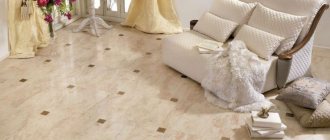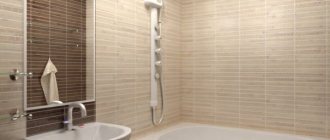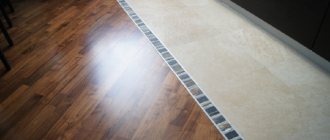Why choose floor tiles
Interior tiles produced by manufacturers are suitable for decorating walls, floors and even ceilings, but at the same time they differ in performance qualities. Home owners are faced with a difficult choice before the upcoming renovation, which depends on the drafted project.
When choosing flooring, many choose tiles for the living room floor
, considering that the use of such materials has undeniable advantages:
- extended service life if care recommendations are followed
- high level of resistance to mechanical stress and abrasion
- a huge selection of colors, sizes and shapes, materials of manufacture
It cannot be said that certain types of floor tiles have only advantages; such coatings also have disadvantages. For example, ceramic tiles can be cold and to neutralize this disadvantage, you can use floor heating systems to avoid discomfort.
Another nuance is that the surface of the coating is too smooth; tiles with a glossy finish are quite slippery, so your choice must be taken as carefully as possible.
Traditional flooring materials
The traditional material for flooring is wood. It has long been used in houses and apartments. Later other materials appeared. The following have gained wide popularity today:
- a natural stone;
- floor tiles;
- parquet;
- laminate;
- carpet;
- cork;
- linoleum.
What material should you choose for your floor? In the kitchen you can put linoleum, or you can have an expensive marble floor. Each coating has its own pros and cons. How to decorate the living room? It is not recommended to skimp on finishing the floor in this room. If you decide to have a wooden floor in the hall, it is better to give preference to parquet or laminate. Laminate is not a very expensive material, but it can imitate various types of wood, tile and stone. Is it possible to put ordinary ceramic or porcelain tiles on the floor in the living room?
The best types of tiles for the living room
The floor in the living room, which is constantly walked on by people, homeowners, guests, and pets, wears out quickly. When choosing a floor covering, it is important to consider all options, and if the main requirement is practicality and wear resistance, you can pay attention to the following options:
- vinyl tiles for living room;
- rubber with additional decor;
- polyvinyl chloride coating;
- quartzvenile floor tiles;
- cork tiles (natural material);
- natural stone floor tiles;
- ceramic, the most common tile.
An interesting and unusual solution would be mirror tiles in the living room interior
with a glossy and reflective coating. This option can be used in combination with other floor coverings as part of finishing or decorative elements, increasing the uniqueness of the room's interior.
Ceramics and its types
The beauty and attractiveness of the interior depends on the harmony and atmosphere of comfort, which can be created by the correct choice of all types of finishing.
The most popular combination of affordable cost and high quality is ceramic tiles, which come in different types:
- metlakhskaya, without a glazed coating and painted through;
- Cotto, with a porous structure and without enamel on the surface;
- clinker, extremely wear-resistant and not very porous in structure;
- porcelain stoneware with a glossy surface and homogeneous structure.
Almost all types of ceramic tiles are easy to care for and install, and do not collapse under prolonged exposure to chemically active substances.
To clean ceramics, you can use strong products that help clean and disinfect the surface while maintaining its attractive appearance.
Technology Features
Ceramic floor tiles for living room
when heated or supercooled, it does not emit harmful substances into the air and has no specific odor. This flooring is produced using modern technologies that differ in certain nuances of production organization:
- extrusion, forcing a plastic mass through special devices;
- pressing, for this process the charge is compacted and given the desired shape;
- monocottura, the dried mass after pressing is treated with glaze;
- bicottura, instead of glaze, high-quality enamel is used for such products.
Depending on the technology used, the finished product has its own distinctive properties. Knowing what technological process was used, you can focus on the properties acquired by the tile, which is important when choosing the best material for decorating the living room.
Tile design
In modern interiors, tiles are often found on the living room floor, photo
finished projects can be used for upcoming renovations. In this case, it is necessary to take into account the design features of the room, the style and the general concept of decorating the room.
Materials for covering heated floors in the living room
Clinker and ceramic tiles for the living room are optimally suited for those rooms in which modern technologies for arranging heated floors are used, because clay after processing has excellent thermal conductivity properties.
It is better to avoid vinyl and PVC tiles; they do not tolerate increased temperatures and can lose their aesthetic appeal when decorating heated floors, preventing the room from warming up and minimizing the heating efficiency.
The best interior design ideas for a living room 18 sq m (120 photos)The best living room interior ideas with a fireplace in a modern style (110 photos)
We make a design project for a room in the Interior Design 3D program
The dimensions of the tiles must be selected individually, taking into account the area of the room, and it is important to choose the adhesive for fixing them based on the installation instructions for the coating. Matte or mirror tiles in the living room can be installed independently, but it is better to entrust this procedure to experienced specialists.
Laying rules and design options
Depending on the shape and size of the individual elements of the floor covering, the method of its installation is also selected. In the assortment of modern manufacturers you can also find ready-made kits, which include design projects; they are placed in the center or in the corners of the room, complemented by a background covering.
Stylistic nuances
Looking at the tile floors in the living room, photo
who are inspired to decorate their own home, you can choose the best style option.
Large or small drawings, geometric shapes and optical illusions are quite popular among modern designers.
Clinker
When choosing a classic, sophisticated and discreet tile design in the living room, you should pay attention to reliable clinker tiles, which are an analogue of ceramic coatings; such materials undergo only one firing stage, but are characterized by good durability.
Glazed and unglazed types of tiles can be used in different areas of the room, it is difficult for them to cause any kind of damage; as a decoration, clinker elements cover the facade of fireplaces or the area in front of them, due to their heat resistance.
What is important to consider when choosing
When choosing high-quality and inexpensive tiles, it is necessary to take into account its environmental friendliness and compliance with sanitary requirements. The higher the porosity of the structure, the greater the likelihood of poor maintenance, but we must not forget about the appearance of the coating, because the tiles should decorate the room.
When planning an upcoming renovation, it is important not to forget about the floor covering, and if you plan to install a heated floor system, tiles will be an ideal option. It warms up well and retains heat for a long time, and in the hot season it gives coolness, decorating the room.
Types of ceramic tiles
Clay is used to make affordable classic ceramic tiles. The result is a thin and porous material; such floor tiles are better suited for rooms with high humidity.
Tile. First, the clay is baked, then an enamel pattern is applied and fired again. Afterwards they are varnished.
Ceramic tiles are thermally conductive, but have a cold surface and are brittle when impacted. Suitable for laying “warm floors”.
Metlakh unglazed tiles are also called majolica. The composition includes carbonate, iron oxide, sand and clay. Majolica, a hard tile with a wear-resistant pattern, covers part of the room.
The base of the mosaic tile is mesh or paper. These tiles are sold in rolls; you can choose tiles for the floor in the bathroom and toilet.
Cotto, a Tuscan clay tile in brick shades, has a thickness of 3 cm. The porous material does not like dirt and requires careful care. A fashionable and original solution for the floor.
White terral tiles, which contain sand and flux, are covered with a pattern before glazing.
To make Gres tiles, a type of porcelain stoneware, kaolin clay, quartz and mica are used. The result is a durable material that is not afraid of scratches and abrasion.
Monocottage tiles are durable, moisture-resistant and wear-resistant, single-firing. Double fired - bicottura tiles.
Replacement for stone - tiles made of porcelain stoneware and clinker. With granite chips, durable as stone, thermally conductive. Porcelain tiles are wide, and clinker tiles are like small bricks.
Disadvantages of ceramic products: some types are brittle when impacted; do not block noise; tactilely cold when touched.
installation difficulties.
Photo of tiles in the living room interior
Share with friends:
Natural stone tiles
You can choose floor tiles from natural stone for the bathroom, hallway, living room:
More: High altitude cleaning
Marble and granite tiles are durable with an original pattern of soft shades. Marble tiles require careful care.
Onyx tiles, with waves and lines in the pattern, are used to decorate individual small areas of the floor.
Tiles made of velvety touch travertine are as durable as granite and marble. Colors range from soft cream shades to dark brown. Combines with wood and is not afraid of moisture.











